Xiangfei Qiu
EasyTime: Time Series Forecasting Made Easy
Dec 23, 2024



Abstract:Time series forecasting has important applications across diverse domains. EasyTime, the system we demonstrate, facilitates easy use of time-series forecasting methods by researchers and practitioners alike. First, EasyTime enables one-click evaluation, enabling researchers to evaluate new forecasting methods using the suite of diverse time series datasets collected in the preexisting time series forecasting benchmark (TFB). This is achieved by leveraging TFB's flexible and consistent evaluation pipeline. Second, when practitioners must perform forecasting on a new dataset, a nontrivial first step is often to find an appropriate forecasting method. EasyTime provides an Automated Ensemble module that combines the promising forecasting methods to yield superior forecasting accuracy compared to individual methods. Third, EasyTime offers a natural language Q&A module leveraging large language models. Given a question like "Which method is best for long term forecasting on time series with strong seasonality?", EasyTime converts the question into SQL queries on the database of results obtained by TFB and then returns an answer in natural language and charts. By demonstrating EasyTime, we intend to show how it is possible to simplify the use of time series forecasting and to offer better support for the development of new generations of time series forecasting methods.
DUET: Dual Clustering Enhanced Multivariate Time Series Forecasting
Dec 14, 2024
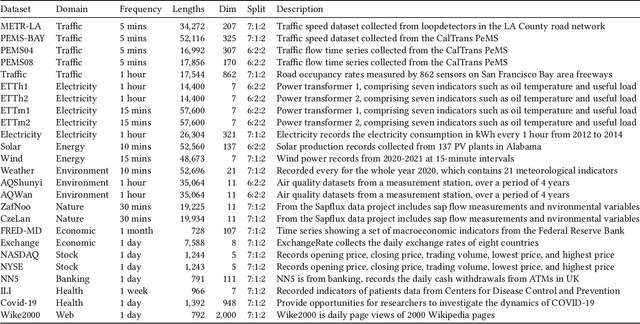


Abstract:Multivariate time series forecasting is crucial for various applications, such as financial investment, energy management, weather forecasting, and traffic optimization. However, accurate forecasting is challenging due to two main factors. First, real-world time series often show heterogeneous temporal patterns caused by distribution shifts over time. Second, correlations among channels are complex and intertwined, making it hard to model the interactions among channels precisely and flexibly. In this study, we address these challenges by proposing a general framework called \textbf{DUET}, which introduces \underline{DU}al clustering on the temporal and channel dimensions to \underline{E}nhance multivariate \underline{T}ime series forecasting. First, we design a Temporal Clustering Module (TCM) that clusters time series into fine-grained distributions to handle heterogeneous temporal patterns. For different distribution clusters, we design various pattern extractors to capture their intrinsic temporal patterns, thus modeling the heterogeneity. Second, we introduce a novel Channel-Soft-Clustering strategy and design a Channel Clustering Module (CCM), which captures the relationships among channels in the frequency domain through metric learning and applies sparsification to mitigate the adverse effects of noisy channels. Finally, DUET combines TCM and CCM to incorporate both the temporal and channel dimensions. Extensive experiments on 25 real-world datasets from 10 application domains, demonstrate the state-of-the-art performance of DUET.
MultiRC: Joint Learning for Time Series Anomaly Prediction and Detection with Multi-scale Reconstructive Contrast
Oct 21, 2024

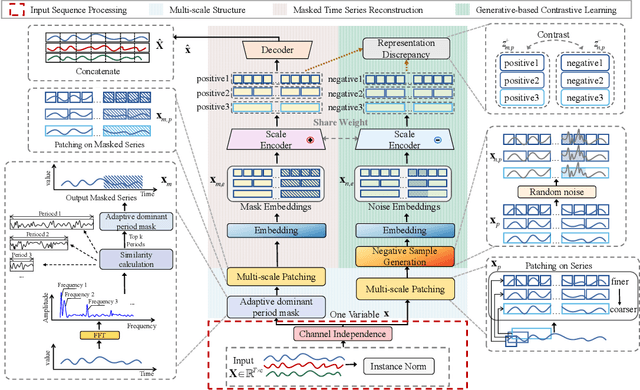

Abstract:Many methods have been proposed for unsupervised time series anomaly detection. Despite some progress, research on predicting future anomalies is still relatively scarce. Predicting anomalies is particularly challenging due to the diverse reaction time and the lack of labeled data. To address these challenges, we propose MultiRC to integrate reconstructive and contrastive learning for joint learning of anomaly prediction and detection, with multi-scale structure and adaptive dominant period mask to deal with the diverse reaction time. MultiRC also generates negative samples to provide essential training momentum for the anomaly prediction tasks and prevent model degradation. We evaluate seven benchmark datasets from different fields. For both anomaly prediction and detection tasks, MultiRC outperforms existing state-of-the-art methods.
DiffImp: Efficient Diffusion Model for Probabilistic Time Series Imputation with Bidirectional Mamba Backbone
Oct 17, 2024



Abstract:Probabilistic time series imputation has been widely applied in real-world scenarios due to its ability to estimate uncertainty of imputation results. Meanwhile, denoising diffusion probabilistic models (DDPMs) have achieved great success in probabilistic time series imputation tasks with its power to model complex distributions. However, current DDPM-based probabilistic time series imputation methodologies are confronted with two types of challenges: 1)~\textit{~The backbone modules of the denoising parts are not capable of achieving sequence modeling with low time complexity.} 2)~\textit{The architecture of denoising modules can not handle the inter-variable and bidirectional dependencies in the time series imputation problem effectively.} To address the first challenge, we integrate the computational efficient state space model, namely Mamba, as the backbone denosing module for DDPMs. To tackle the second challenge, we carefully devise several SSM-based blocks for bidirectional modeling and inter-variable relation understanding. Experimental results demonstrate that our approach can achieve state-of-the-art time series imputation results on multiple datasets, different missing scenarios and missing ratios.
CATCH: Channel-Aware multivariate Time Series Anomaly Detection via Frequency Patching
Oct 16, 2024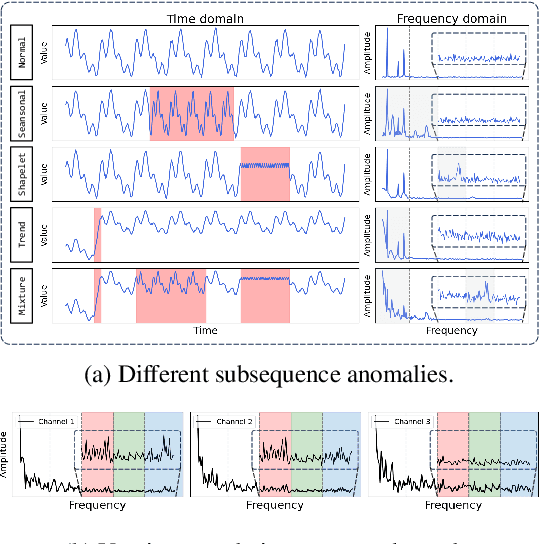

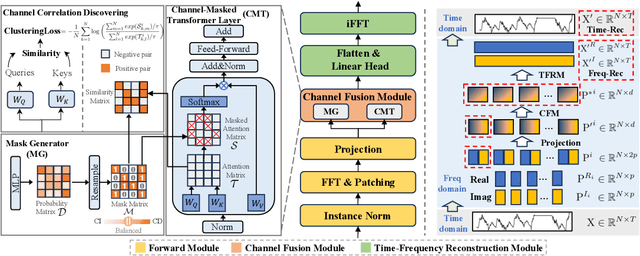

Abstract:Anomaly detection in multivariate time series is challenging as heterogeneous subsequence anomalies may occur. Reconstruction-based methods, which focus on learning nomral patterns in the frequency domain to detect diverse abnormal subsequences, achieve promising resutls, while still falling short on capturing fine-grained frequency characteristics and channel correlations. To contend with the limitations, we introduce CATCH, a framework based on frequency patching. We propose to patchify the frequency domain into frequency bands, which enhances its ability to capture fine-grained frequency characteristics. To perceive appropriate channel correlations, we propose a Channel Fusion Module (CFM), which features a patch-wise mask generator and a masked-attention mechanism. Driven by a bi-level multi-objective optimization algorithm, the CFM is encouraged to iteratively discover appropriate patch-wise channel correlations, and to cluster relevant channels while isolating adverse effects from irrelevant channels. Extensive experiments on 9 real-world datasets and 12 synthetic datasets demonstrate that CATCH achieves state-of-the-art performance.
FoundTS: Comprehensive and Unified Benchmarking of Foundation Models for Time Series Forecasting
Oct 15, 2024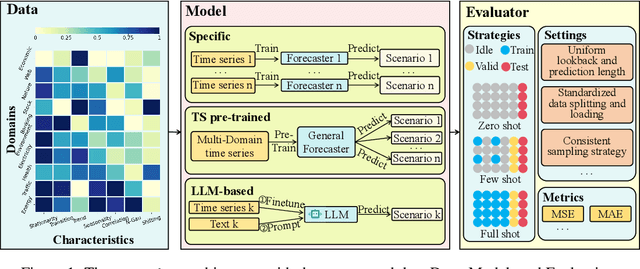
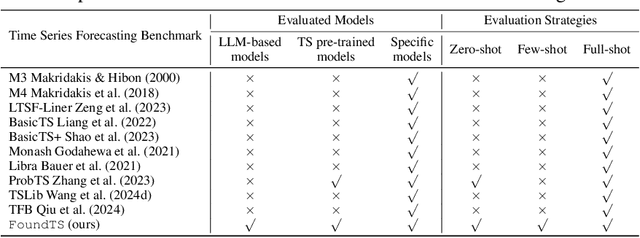
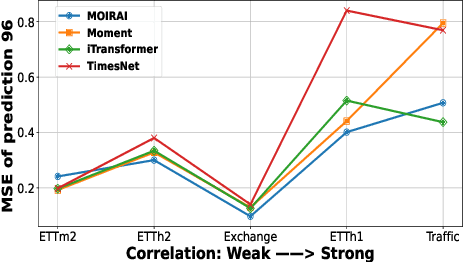
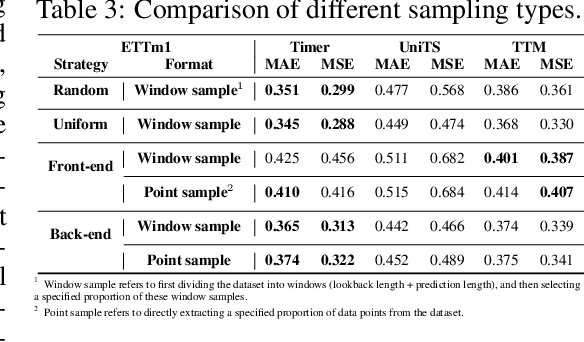
Abstract:Time Series Forecasting (TSF) is key functionality in numerous fields, including in finance, weather services, and energy management. While TSF methods are emerging these days, many of them require domain-specific data collection and model training and struggle with poor generalization performance on new domains. Foundation models aim to overcome this limitation. Pre-trained on large-scale language or time series data, they exhibit promising inferencing capabilities in new or unseen data. This has spurred a surge in new TSF foundation models. We propose a new benchmark, FoundTS, to enable thorough and fair evaluation and comparison of such models. FoundTS covers a variety of TSF foundation models, including those based on large language models and those pretrained on time series. Next, FoundTS supports different forecasting strategies, including zero-shot, few-shot, and full-shot, thereby facilitating more thorough evaluations. Finally, FoundTS offers a pipeline that standardizes evaluation processes such as dataset splitting, loading, normalization, and few-shot sampling, thereby facilitating fair evaluations. Building on this, we report on an extensive evaluation of TSF foundation models on a broad range of datasets from diverse domains and with different statistical characteristics. Specifically, we identify pros and cons and inherent limitations of existing foundation models, and we identify directions for future model design. We make our code and datasets available at https://anonymous.4open.science/r/FoundTS-C2B0.
TFB: Towards Comprehensive and Fair Benchmarking of Time Series Forecasting Methods
Apr 08, 2024



Abstract:Time series are generated in diverse domains such as economic, traffic, health, and energy, where forecasting of future values has numerous important applications. Not surprisingly, many forecasting methods are being proposed. To ensure progress, it is essential to be able to study and compare such methods empirically in a comprehensive and reliable manner. To achieve this, we propose TFB, an automated benchmark for Time Series Forecasting (TSF) methods. TFB advances the state-of-the-art by addressing shortcomings related to datasets, comparison methods, and evaluation pipelines: 1) insufficient coverage of data domains, 2) stereotype bias against traditional methods, and 3) inconsistent and inflexible pipelines. To achieve better domain coverage, we include datasets from 10 different domains: traffic, electricity, energy, the environment, nature, economic, stock markets, banking, health, and the web. We also provide a time series characterization to ensure that the selected datasets are comprehensive. To remove biases against some methods, we include a diverse range of methods, including statistical learning, machine learning, and deep learning methods, and we also support a variety of evaluation strategies and metrics to ensure a more comprehensive evaluations of different methods. To support the integration of different methods into the benchmark and enable fair comparisons, TFB features a flexible and scalable pipeline that eliminates biases. Next, we employ TFB to perform a thorough evaluation of 21 Univariate Time Series Forecasting (UTSF) methods on 8,068 univariate time series and 14 Multivariate Time Series Forecasting (MTSF) methods on 25 datasets. The benchmark code and data are available at https://github.com/decisionintelligence/TFB.
 Add to Chrome
Add to Chrome Add to Firefox
Add to Firefox Add to Edge
Add to Edge